Woodpeckers are fascinating birds with the ability to use their powerful bills to drill holes into trees. This produces a distinctive sound that can echo throughout a forest. Typically, woodpeckers drill on wood in order to find food, create space for nesting, communicate their territory, or find a mate. Woodpeckers are also a federally protected species under the North American Migratory Bird Act.
Unfortunately, woodpeckers can also turn their attention to human homes, where they can become quite a nuisance. Their boring can cause damage to a home’s siding, and their droppings can create stains. The pecking sound can be a source of deep frustration for people inside the home. Keep reading to discover eleven ways to get rid of woodpeckers naturally without relying on harsh chemicals that could be damaging to the birds or the environment.
1. Make Loud Noises
Even though woodpeckers produce plenty of loud noises themselves, they will shy away from loud noises they perceive as threats. If you hear a woodpecker drumming on your house, try banging a pot with a wooden spoon or giving a quick blast with an air horn to scare the bird off.
You can also use an app to imitate the sounds of birds that prey on woodpeckers, like hawks or grackles. This approach is not permanent, however, and you may need to scare the woodpecker off repeatedly, running the risk of upsetting your neighbors with unexpected loud noises.
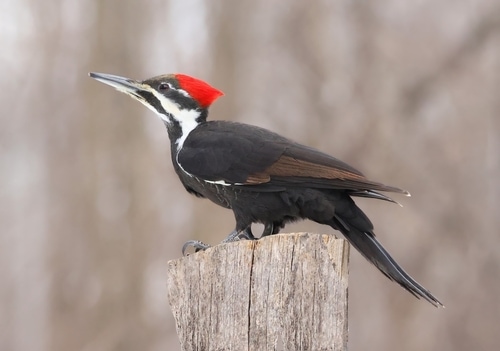
Woodpeckers have feathers over their nostrils to block wood debris from entering while boring holes.
©Vlad G/Shutterstock.com
2. Hang Shiny Objects
When shiny objects reflect light, it can trick woodpeckers into thinking there’s a predator nearby. Objects that blow in the breeze can also disrupt the birds’ flight paths.
If you want to get rid of woodpeckers in your yard, try hanging shiny objects like CDs on a piece of string. Alternatively, wind chimes are a more visually appealing option, with the added bonus of creating noise that could keep woodpeckers away. One possible downside is that the glint and glare from shiny objects could also be distracting for people, so you may need to experiment with different locations.

Woodpeckers have zygodactyl feet, which means their first and fourth toes are backward, allowing them to grip firmly onto trees.
©Danita Delimont/Shutterstock.com
3. Install Aluminum Flashing
You can create a physical barrier between the woodpecker and your home by installing aluminum flashing over holes. Woodpeckers will avoid pecking on aluminum, and its shininess can also be a deterrent.
This solution can be unsightly, depending on the size, number, and location of the holes. It may also require climbing a ladder to reach damaged areas, but aluminum flashing is a deterrent that will not harm the woodpeckers.
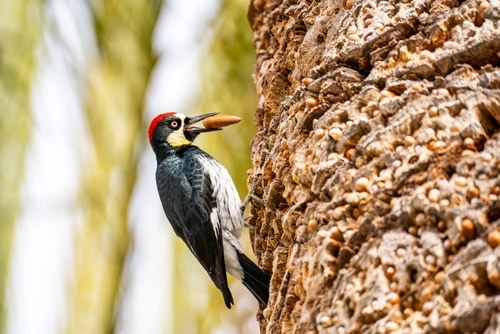
There are nearly 200 different species of woodpeckers.
©Iv-olga/Shutterstock.com
4. Use Decoy Predators
You can make your house less inviting to woodpeckers by installing decoy birds of prey. Plastic owl or hawk figures might be intimidating enough to scare woodpeckers away from your property. These can typically be found online or in garden supply stores, but they are most effective when moved to a different spot every few days.
If you’d like to try a lower-cost solution first, you can draw scary eyes onto blown-up balloons. Make sure you attach the balloons securely to your home so they don’t drift away and turn into litter.
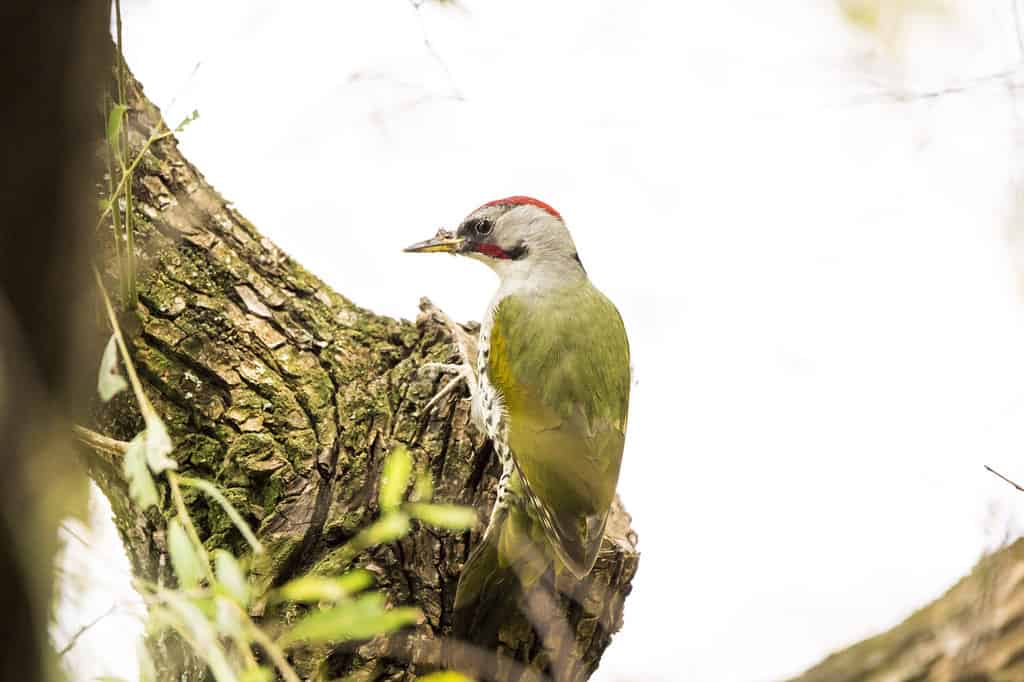
Woodpeckers have federal protection under the North American Migratory Bird Act.
©Naoto Shinkai/Shutterstock.com
5. Install Nest Boxes
One reason woodpeckers create holes is to make nests, so an option to get rid of woodpeckers is to install nest boxes. This provides the birds with an alternative for shelter that doesn’t involve damaging your house.
Make sure to place the nest box as far from your house as you can while still replicating the bird’s natural habitat. This is not an immediate solution, and it may take time for woodpeckers to explore the nest box. This solution is most likely to be effective when combined with other tactics.

Tree trunks provide an ideal nesting spot for woodpeckers.
©silentstock639/Shutterstock.com
6. Hang Netting
Netting is another physical barrier that can prevent woodpeckers from reaching your house. Attach the net from your house’s eave and secure it to the ground. Make sure to leave a few inches of space between the net and your home’s siding to prevent woodpeckers from reaching through.
This solution can also be unsightly and may need to be semi-permanent for the best effect. Some homeowners choose to install hooks under their eaves to hang netting when necessary.
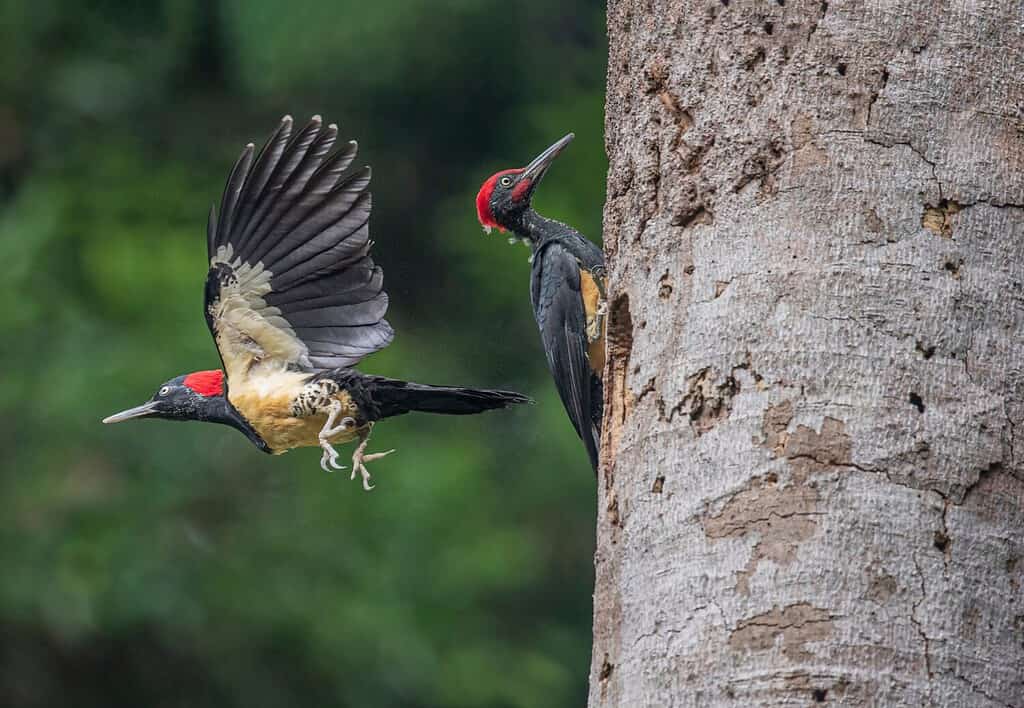
Woodpeckers have tongues that are twice the length of their beaks, providing protection for their brains by absorbing the shock of drumming on wood.
©Jamil Bin Mat Isa/Shutterstock.com
7. Use Scents
Certain scents can deter woodpeckers. Try spraying diluting peppermint or cinnamon essential oils in a bottle and spraying on the outside of your house.
Lavender, catnip, basil, and rosemary are herbs that are irritating to woodpeckers. You could apply diluted essential oils to the outside of your home, hang sachets full of dried plants outside, or include these plants in your home’s landscaping to help get rid of woodpeckers.
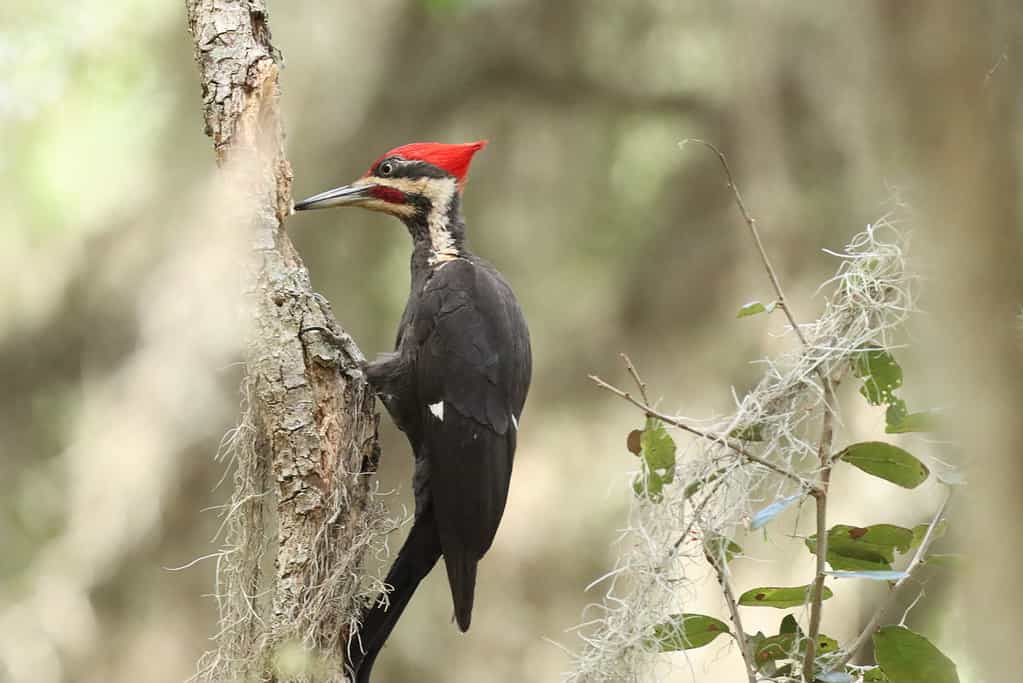
The
ivory-billed woodpecker
, shown here, is thought by many to be extinct, but unconfirmed sightings have given researchers hope.
©Wirestock/iStock via Getty Images
8. Turn On Your Sprinklers
Woodpeckers prefer to avoid hanging onto wet structures. You can try setting up a garden hose and a sprinkler to hit the areas where woodpeckers have been making holes.
The birds will not be harmed if the sprinkler gets them wet, but they might be less interested in returning to that spot. This solution may not be ideal if it introduces water to damaged siding, so be sure you’ve applied aluminum flashing or patched holes first.
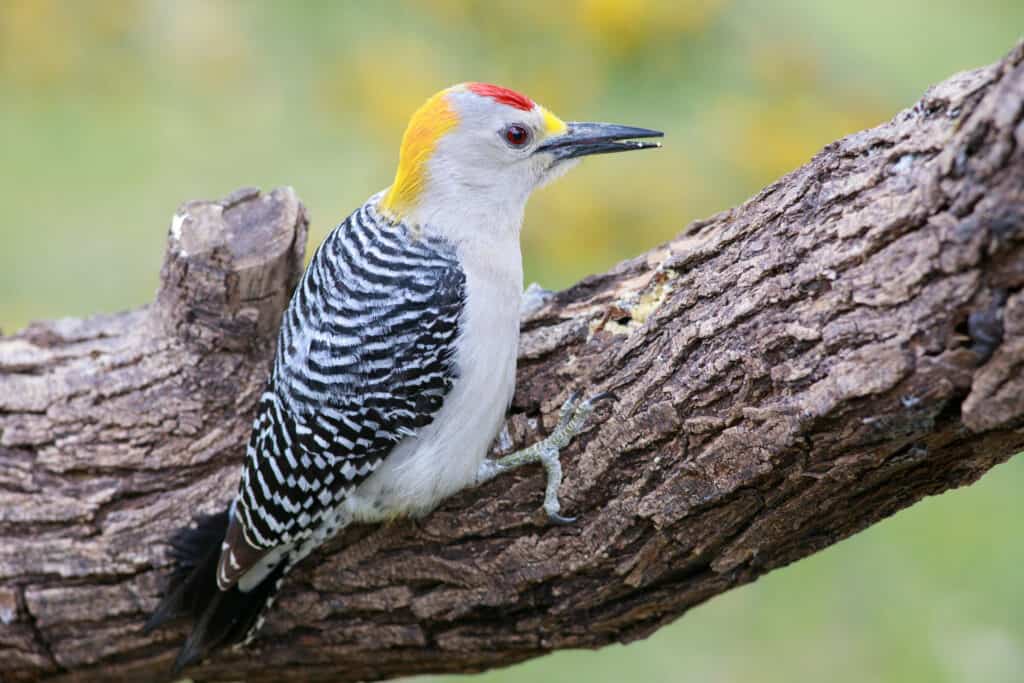
Drumming is also a way for woodpeckers to communicate.
©Raul Baena/Shutterstock.com
9. Provide Alternate Food Sources
Aside from nesting, woodpeckers will also drill holes in order to search for or hide food. You can try to entice woodpeckers away from your home by providing them with additional food sources.
For a quick solution, try hanging a suet feeder. For a longer-term solution, you can plant berry bushes or fruit trees. If possible, these should be located near nesting boxes to encourage woodpeckers to utilize them. Keep in mind that it could take months or years for a plant to produce fruit, and you may end up attracting the attention of other birds and animals with this strategy.

Female woodpeckers typically lay two to five eggs.
©FloridaStock/Shutterstock.com
10. Fix or Replace Damaged Wood
Rotting wood can provide the birds with an easy place to build a nest or store food. To get rid of woodpeckers that are targeting your home, take time to inspect the outside of your house for needed repairs.
You can use wood putty to plug any smaller holes, but any larger areas with rotted wood should ideally be replaced. This may not be possible in all cases, and you may need to consult with a professional contractor to consider options for repair.
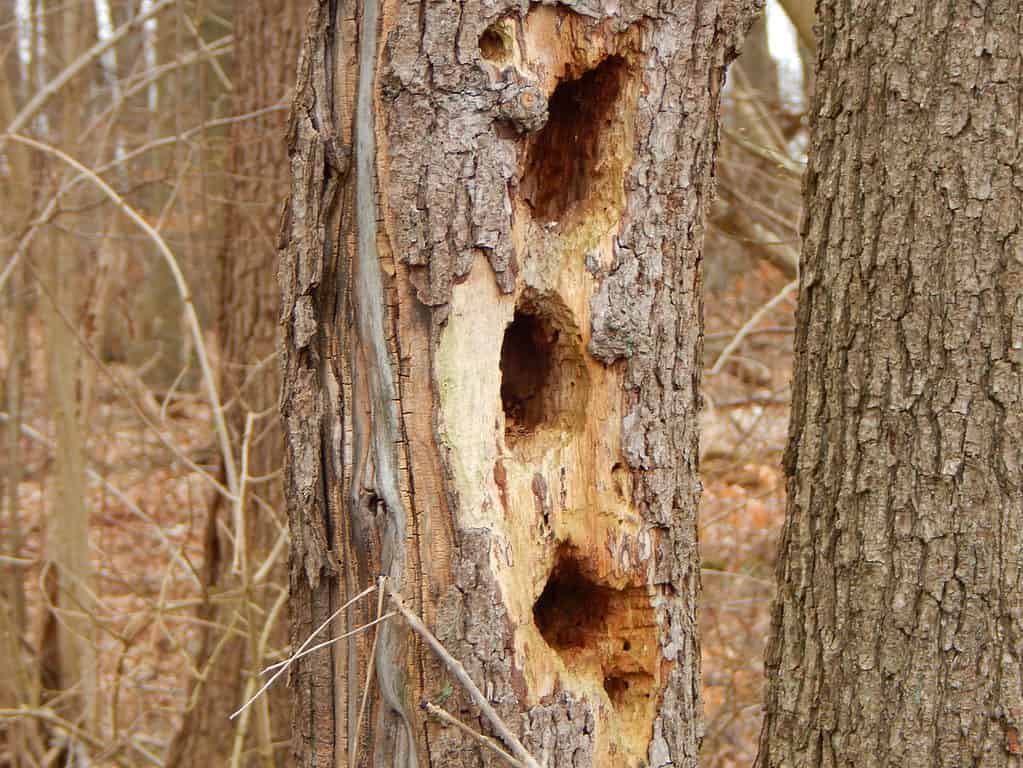
If left unchecked, woodpeckers can cause significant damage.
©iStock.com/Kurt-Erik Goehner
11. Check for Bugs
Sometimes, when woodpeckers are persistent about making holes in your house, they are alerting you to the presence of bugs or insects. Woodpeckers eat insects and insect larvae, including termites, wasps, carpenter bees, and ants.
If you discover a nest or colony of insects, there are natural options to rid yourself of the pests. These options may take a little longer to be effective, but you’ll have the assurance that you’re avoiding harm to the woodpeckers and other birds around your home.
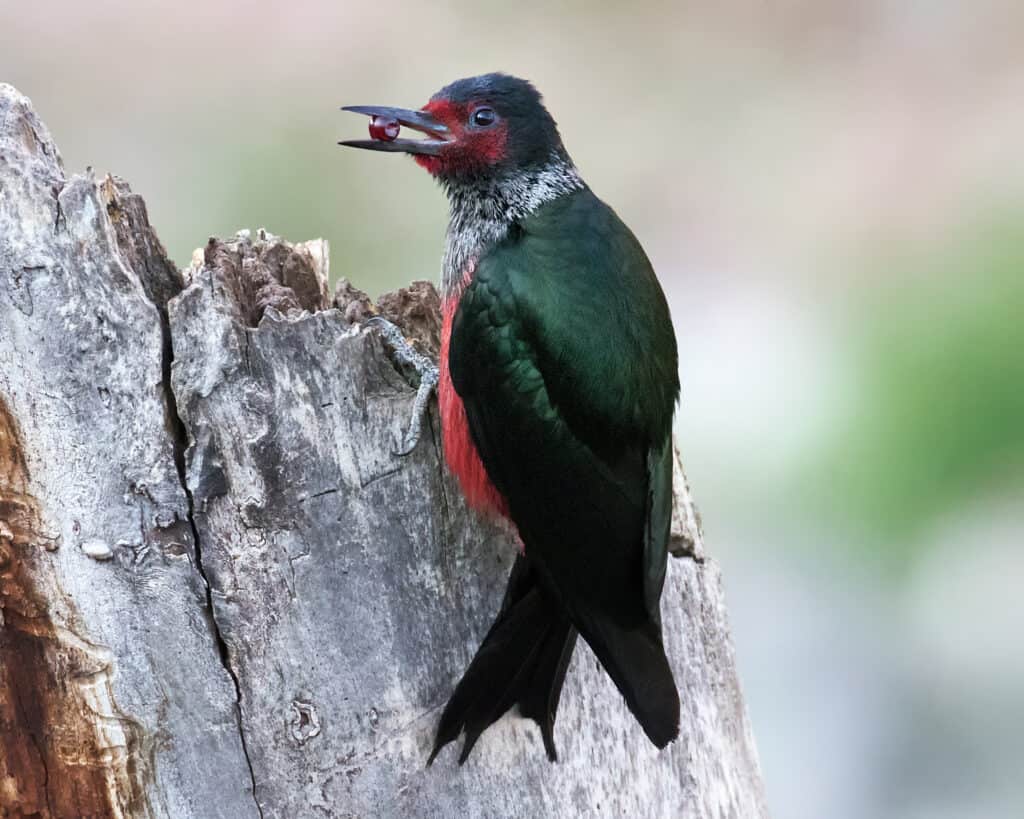
Along with bugs, woodpeckers will eat acorns, small lizards, fruit, and seeds.
©rbrown10/Shutterstock.com
| Method | |
|---|---|
| #1 | Make Loud Noises |
| #2 | Hang Shiny Objects |
| #3 | Install Aluminum Flashing |
| #4 | Use Decoy Predators |
| #5 | Install Nest Boxes |
| #6 | Hang Netting |
| #7 | Use Scents |
| #8 | Turn On Your Sprinklers |
| #9 | Provide Alternate Food Sources |
| #10 | Fix or Replace Damaged Wood |
| #11 | Check for Bugs |
The photo featured at the top of this post is © silentstock639/Shutterstock.com
Thank you for reading! Have some feedback for us? Contact the AZ Animals editorial team.







